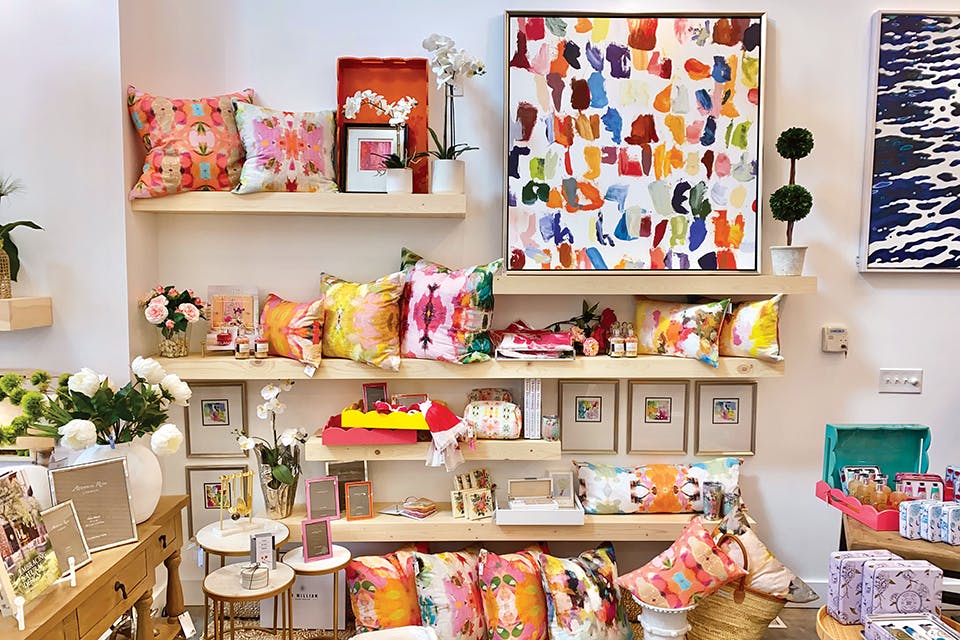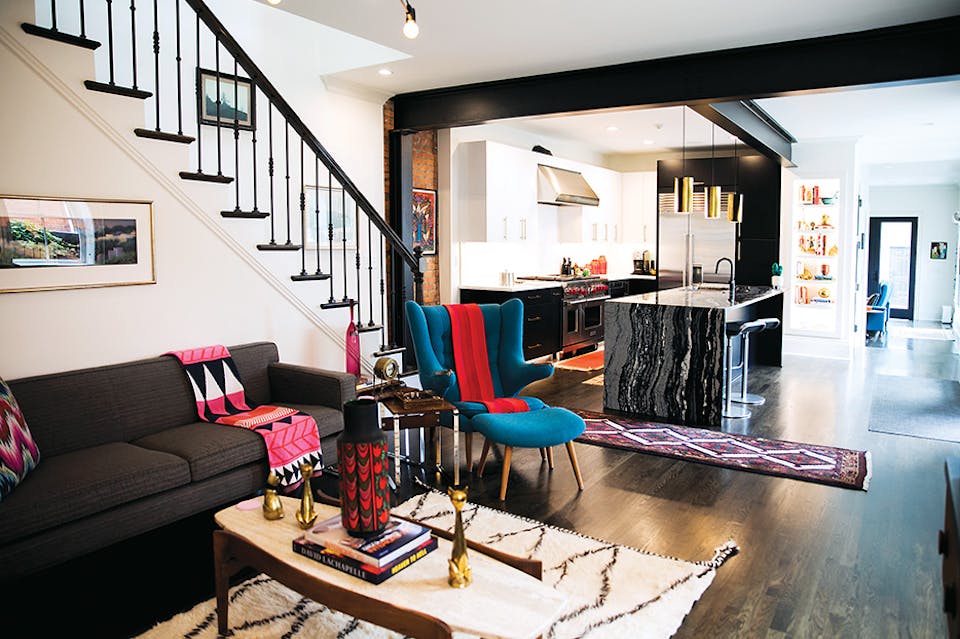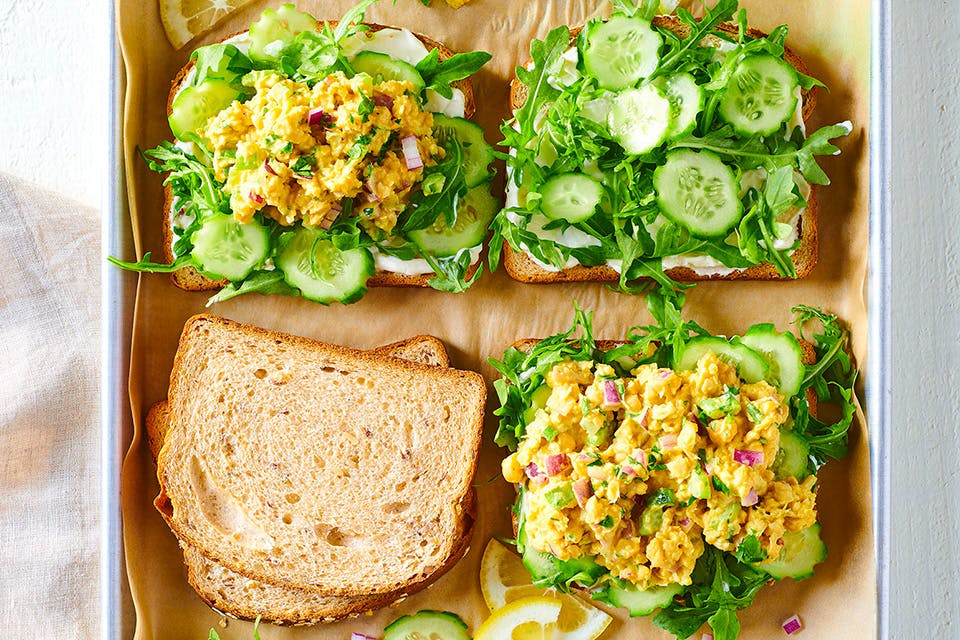Less Is More
Southeast Ohio’s Blue Rock Station is an oasis of rural, sustainable living.
September 2013 Issue
BY Ron Rollins | ART BY
September 2013 Issue
BY Ron Rollins | ART BY
There are hints, as soon as you arrive, that this place is not quite like other farms you've seen.
There are the flags, for one thing. Among them are Brazil, New Zealand and Norway — they line the entrance to the small parking lot off the narrow, winding country road. Each comes with a story related to people who are special to the farm’s owners. Right off the parking lot sits a red-painted goat barn, part of which appears to be constructed of adobe and glass. In this vinyl-sided world, it stands out. A few feet away, a rounded structure looms up, two stories high, a concoction of wood and adobe that is still under construction.
Chickens wander about, seeking shade. The goats come to the fence line, willing to make friends. Cars are pulling in, a crowd gathering.
Welcome to Blue Rock Station. Hidden in the low hills of southeastern Ohio, near the village of Philo in Muskingum County, it’s a high-concept, experimental lifestyle center that is all about frugality, green architecture and sustainable, low-impact living. More than 20,000 people have visited and toured since 2005; interns have come from campuses around the world to learn and help improve the complex.
It is the creation and home of Annie and Jay Warmke, two people who once lived in the same world most of us occupy — one of miles carelessly driven, light switches casually flipped, water easily wasted, cans and bottles thoughtlessly tossed. But even while they were in it, the Warmkes felt uneasy about that world, and when they got a chance to live differently, they took it. That chance led them to Ohio, and the place that has become Blue Rock Station — part dwelling, part farm, part laboratory, part classroom, part showroom — a place like no other in the state.
Jay arrives, wearing a straw hat and Hawaiian shirt, at the edge of the parking lot to welcome the visitors and lead a tour of the property. At every stop, he speaks fervently about how Americans live too wastefully, and how there is a better way.
When he gets to the centerpiece of the farm — the Warmkes’ home, aka the Earthship — he starts talking about how many tires Americans use each year (350 million). The reason? The house is built mostly from 1,400 discarded tires, hammer-packed with earth. It has large south-facing windows and an earthen backside that keeps it a steady 55 degrees in winter. Designed by Michael Reynolds of Taos, New Mexico, who has built several similar homes in the southwestern U.S., the Warmkes’ Earthship was the first in Ohio.
The original house, built starting in 1996 and finished over several years, was 1,600 square feet with a living room, kitchen, laundry room, shower room and two bedrooms. A brick-floored sitting room, dubbed the SunPorch (everything at Blue Rock has a name, it seems), added later made the house 2,200 square feet. It incorporates repurposed bottles that provide trapped-air insulation and soundproofing, and a 5,000-gallon cistern that catches roof rainwater for all the family’s needs. Outside is a composting toilet. Raised gardens made of logs contain tomatoes and vegetable plants.
“It’s basically a clay house,” Annie explains. “People ask, why tires? They’re just a form for making a big brick, essentially.”
Reduce, reuse, recycle. Inside, the round living room ceiling is covered in pressed-tin panels saved from a demolished shop in Zanesville. The books on the shelves are mostly second-hand. In the kitchen, the counters and steel drawers were retrieved from the old Philo high school before it was razed. The kitchen sink empties into a dirt-filled “wetland” enclosure sprouting big banana and avocado trees, which absorb and recycle the gray water. In the nearby SunPorch, the Rocket Stove for cooking and heating the room is made from mud and a 55-gallon drum. Annie and an intern designed it.
Outside, there’s a solar oven for cooking. The guests who’ve arrived for today’s tour hear Jay talk about how to use it, and how it was made, before he talks about wind and solar energy — a subject he teaches and writes about. In a few minutes, Annie will serve tea and delicious rose water, along with their own apples, goat cheese and some lovely baked sweets.
“I want to live an honest, simpler life, basically,” she says. “Living honestly is about knowing how much water you’re using, and knowing where it comes from and that it’s safe. It’s about knowing how much energy you’re using. I like that awareness — it’s a very rich life, and we’re lucky to live this way.”
So, how did they end up here? Annie, in the small book she wrote about their lives, The Journey Toward Nothing, says she had for most of her life felt a tug toward simpler, more conscious living, and credits her Ohio grandparents.
Originally from Columbus, Annie moved to Florida, and gained a national reputation working with and advocating for battered women, drawing in part upon her own experience as a battered spouse at the hands of her first husband. She met and fell in love with Jay, an entrepreneur whose biggest business was national comic-book distribution, in which he dealt with big names like Marvel. Jay was born in Colorado but spent some of his childhood in Athens, Ohio.
Annie was thinking of finding a retreat in the country where she could start that simpler life. When their granddaughter, Catlyn, was born in Zanesville in 1993, Annie and Jay wanted to live nearby. They bought 38 acres about half an hour south, and started working on Blue Rock Station.
“For me,” Jay says, “it was never like an epiphany or anything, that I would choose to live this way. I would have been the least likely person to buy into the whole sustainability thing. But Annie convinced me to look into building this house, and I realized I liked being in a place where I have and use less. Every time I decide to give something up, and live with less, I’m happier.
“And,” he adds with a laugh, “it plays into my sense of cheapness.”
Now, 19-year-old Catlyn lives with them on the farm, and there are usually a couple of interns around, too. They dwell in the outbuildings that are also a part of what makes Blue Rock so remarkable.
There is, for instance, the greenhouse made from 1,000 two-liter pop bottles. Nearby is the adobe-sided A-frame Chicken Chalet, roofed with reused slate shingles from local barns. A barn, a shed, a cabin and the privy are all built from straw bales and adobe. There’s a cottage with a living roof, earth-filled and covered with plants, for insulation. Another intern’s cottage is a converted, modified yard shed of the sort found in suburban back yards, but which here is an inviting, tiny house, the Happy Nest. That half-built structure we saw off the parking lot? It will be the Blue Loo, a composting public toilet with a living roof, a second-floor overlook and a wind-powered hand-washing station.
Down the path, there’s the Llama Lounge, an open-sided stable for the llamas whose manure is sold to farmers to use in fertilizer “tea.” The farm’s only other cash crop is the willow harvested and sold for everything from baskets to tomato stakes.
But the Warmkes don’t need a lot of money. They are still hooked into the electrical grid, but use very little power, and Jay — a proponent and teacher of sustainable energy sources such as wind and solar — hopes to disconnect all the way. The couple makes a modest living sharing the concepts of sustainability by which they live — teaching, consulting, writing and running workshops and tours of the farm. They teach how to make the pop-bottle greenhouse, and how to construct a straw-bale house. They conduct llama treks, during which visitors can hike the woods with the critters in tow. They have several books for sale, on everything from animal care to raising goats. (“I don’t own the goats; they’re my partners,” Annie says. “I take care of them, and their part is to make milk I can turn into cheese.”) They send out a friendly, useful e-newsletter, and their website is both a teaching tool and a promotion for the farm.
The idea the Warmkes are most proud of is “Thanks For Nothing” Month. They’ve spent the last two Januaries living without spending any money or using energy. Needless to say, this takes a lot of planning, a desire to go without a lot of things, and a willingness to hunker down and live within the rhythms of the natural world. Jay says it’s become his favorite time of year. “It’s a month of peace,” he says.
Annie agrees, and is pleased to be able to share with a visitor all the richness she feels she’s found from a lifestyle that isn’t always easy, but which is far less complicated than the one she left behind. Jay, as always, is her ready partner on the trip.
“You know, Annie and I will be sitting on the patio drinking tea in the evening after working on the farm, and looking out over that pretty valley,” he says, “and she’ll turn to me and say, ‘Isn’t this just the most wonderful place in the world? Don’t you feel so rich?’ And I think, ‘Yeah, this is nice.’ ”
When You Go
Blue Rock Station is located at 1190 Virginia Ridge Rd., Philo 43771. For more information, visit bluerockstation.com or call 740/674-4300.
The Warmkes’ website gives a complete rundown of their books, workshops, tours and tips on how to live sustainably. There’s a blog about daily life on the farm, and a link to their newsletter. If you want to visit for a tour, reservations are required. Check the site for directions and read them carefully — Blue Rock Station isn’t easy to find, and you should follow the very detailed directions they provide.
Related Articles

Gather by Angel 101, Perrysburg
Angel Elden wants to bring back the idea of gathering around the table together with a new store that helps people create an inviting home. READ MORE >>

Step Inside 3 Homes in Columbus’ German Village
This neighborhood has long been a place filled with beautifully renovated historic homes. Three homeowners invited us in. READ MORE >>

4 Fresh & Simple Sandwich Recipes
Josh Thurston, sous chef at Kindred Spirits at the Inn & Spa at Cedar Falls, and Josh Sheets, owner of Ol’ Dirty Sheets Hot Sauce, share fresh ideas from their own kitchens. READ MORE >>

